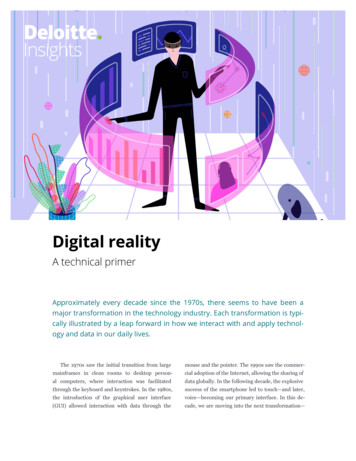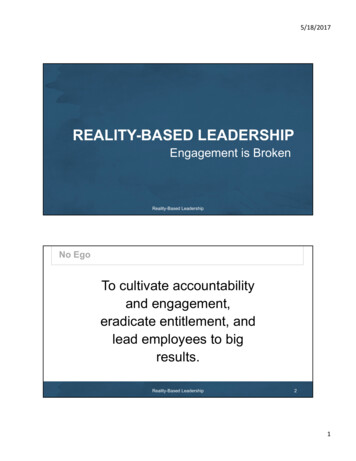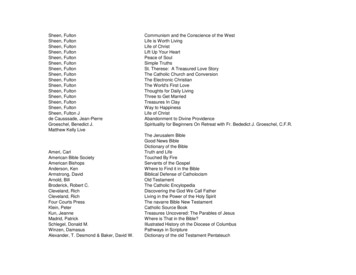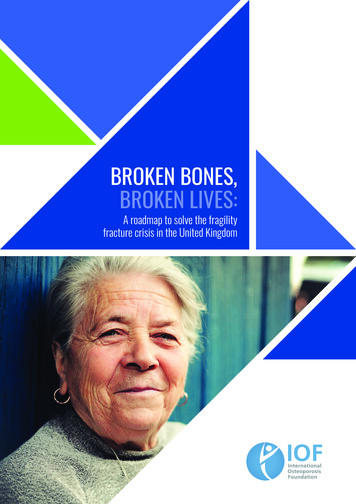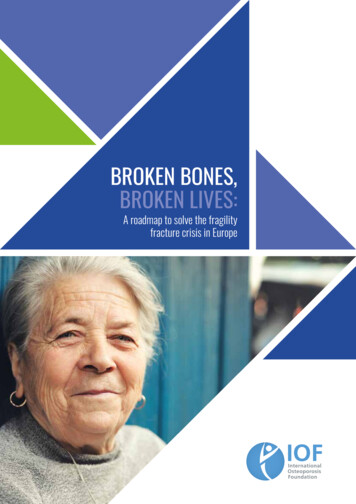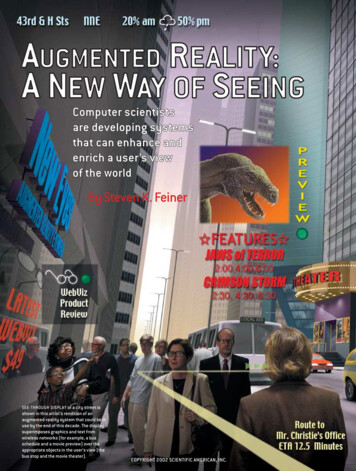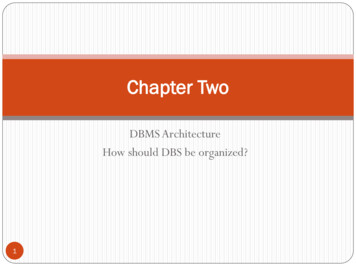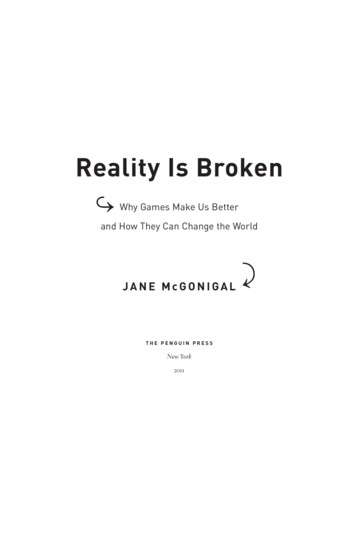
Transcription
Reality Is BrokenaWhy Games Make Us Betterand How They Can Change the WorldJANE McGONIGALTHE PENGUIN PRESSNew York2011E
It is games that give us something to do when there isnothing to do. We thus call games “pastimes” and regardthem as trifling fillers of the interstices of our lives. Butthey are much more important than that. They are cluesto the future. And their serious cultivation now is perhapsour only salvation.—bernard suits , philosopher1
INTRODUCTIONReality Is BrokenAnyone who sees a hurricane coming should warn others.I see a hurricane coming.Over the next generation or two, ever larger numbers ofpeople, hundreds of millions, will become immersed in virtual worlds and online games. While we are playing, thingswe used to do on the outside, in “reality,” won’t be happening anymore, or won’t be happening in the same way. Youcan’t pull millions of person-hours out of a society without creating an atmospheric-level event.If it happens in a generation, I think the twenty-firstcentury will see a social cataclysm larger than that causedby cars, radios, and TV, combined. . . . The exodus of thesepeople from the real world, from our normal daily life, willcreate a change in social climate that makes global warming look like a tempest in a teacup.—edward castronova,Exodus to the Virtual World1
Gamers have had enough of reality.They are abandoning it in droves—a few hours here, an entireweekend there, sometimes every spare minute of every day for stretchesat a time—in favor of simulated environments and online games. Maybe youare one of these gamers. If not, then you definitely know some of them.Who are they? They are the nine-to-fivers who come home and apply allof the smarts and talents that are underutilized at work to plan and coordinatecomplex raids and quests in massively multiplayer online games like FinalFantasy XI and the Lineage worlds. They’re the music lovers who have invested hundreds of dollars on plastic Rock Band and Guitar Hero instrumentsand spent night after night rehearsing, in order to become virtuosos of videogame performance.They’re the World of Warcraft fans who are so intent on mastering thechallenges of their favorite game that, collectively, they’ve written a quarterof a million wiki articles on the WoWWiki—creating the single largest wikiafter Wikipedia. They’re the Brain Age and Mario Kart players who take handheld game consoles everywhere they go, sneaking in short puzzles, races, andminigames as often as possible, and as a result nearly eliminating mentaldowntime from their lives.They’re the United States troops stationed overseas who dedicate so manyhours a week to burnishing their Halo 3 in-game service record that earningvirtual combat medals is widely known as the most popular activity for off-dutysoldiers. They’re the young adults in China who have spent so much playmoney, or “QQ coins,” on magical swords and other powerful game objectsthat the People’s Bank of China intervened to prevent the devaluation of theyuan, China’s real-world currency.2Most of all, they’re the kids and teenagers worldwide who would ratherspend hours in front of just about any computer game or video game than doanything else.These gamers aren’t rejecting reality entirely. They have jobs, goals, school-
Reality Is Broken 3work, families, commitments, and real lives that they care about. But as theydevote more and more of their free time to game worlds, the real world increasingly feels like it’s missing something.Gamers want to know: Where, in the real world, is that gamer sense of beingfully alive, focused, and engaged in every moment? Where is the gamer feelingof power, heroic purpose, and community? Where are the bursts of exhilarating and creative game accomplishment? Where is the heart-expanding thrillof success and team victory? While gamers may experience these pleasuresoccasionally in their real lives, they experience them almost constantly whenthey’re playing their favorite games.The real world just doesn’t offer up as easily the carefully designed pleasures, the thrilling challenges, and the powerful social bonding afforded byvirtual environments. Reality doesn’t motivate us as effectively. Reality isn’tengineered to maximize our potential. Reality wasn’t designed from the bottom up to make us happy.And so, there is a growing perception in the gaming community:Reality, compared to games, is broken.In fact, it is more than a perception. It’s a phenomenon. Economist EdwardCastronova calls it a “mass exodus” to game spaces, and you can see it alreadyhappening in the numbers. Hundreds of millions of people worldwide areopting out of reality for larger and larger chunks of time. In the United Statesalone, there are 183 million active gamers (individuals who, in surveys, report that they play computer or video games “regularly”—on average, thirteenhours a week).3 Globally, the online gamer community—including console,PC, and mobile phone gaming—counts more than 4 million gamers in theMiddle East, 10 million in Russia, 105 million in India, 10 million in Vietnam, 10 million in Mexico, 13 million in Central and South America, 15million in Australia, 17 million in South Korea, 100 million in Europe, and200 million in China.4Although a typical gamer plays for just an hour or two a day, there are nowmore than 6 million people in China who spend at least twenty-two hours aweek gaming, the equivalent of a part-time job.5 More than 10 million “hardcore” gamers in the United Kingdom, France, and Germany spend at least
4 REALITY IS BROKENtwenty hours a week playing.6 And at the leading edge of this growth curve,more than 5 million “extreme” gamers in the United States play on averageforty-five hours a week.7With all of this play, we have turned digital games—for our computers, forour mobile phones, and for our home entertainment systems—into what isexpected to be a 68 billion industry annually by the year 2012.8 And we arecreating a massive virtual silo of cognitive effort, emotional energy, and collective attention lavished on game worlds instead of on the real world.The ever-skyrocketing amounts of time and money spent on games are beingobserved with alarm by some—concerned parents, teachers, and politicians—and eagerness by others—the many technology industries that expect to profitgreatly from the game boom. Meanwhile, they are met with bewilderment anddisdain by more than a few nongamers, who still make up nearly half of theU.S. population, although their numbers are rapidly decreasing. Many of themdeem gaming a clear waste of time.As we make these value judgments, hold moral debates over the addictivequality of games, and simultaneously rush to achieve massive industry expansion, a vital point is being missed. The fact that so many people of all ages, allover the world, are choosing to spend so much time in game worlds is a signof something important, a truth that we urgently need to recognize.The truth is this: in today’s society, computer and video games are fulfillinggenuine human needs that the real world is currently unable to satisfy. Gamesare providing rewards that reality is not. They are teaching and inspiring andengaging us in ways that reality is not. They are bringing us together in waysthat reality is not.And unless something dramatic happens to reverse the resulting exodus,we’re fast on our way to becoming a society in which a substantial portionof our population devotes its greatest efforts to playing games, creates its bestmemories in game environments, and experiences its biggest successes ingame worlds.Maybe this sounds hard to believe. To a nongamer, this forecast mightseem surreal, or like science fiction. Are huge swaths of civilization really
Reality Is Broken 5disappearing into game worlds? Are we really rushing headlong into a future where the majority of us use games to satisfy many of our most important needs?If so, it will not be the first time that such a mass exodus from reality togames has occurred. Indeed, the very first written history of human gameplay,Herodotus’ Histories, the ancient Greek account of the Persian Wars—datingback more than three thousand years—describes a nearly identical scenario.While the oldest known game is the ancient counting game Mancala—evidence shows it was played during Egypt’s age of empires, or the fifteenthto the eleventh centuries BC—it was not until Herodotus that anyone thoughtto record the origins or cultural functions of these games. And from his ancient text, we can learn a great deal about what’s happening today—and what’salmost certainly coming next.It’s a bit counterintuitive to think about the future in terms of the past. Butas a research director at the Institute for the Future—a nonprofit think tank inPalo Alto, California, and the world’s oldest future-forecasting organization—I’ve learned an important trick: to develop foresight, you need to practice hindsight. Technologies, cultures, and climates may change, but our basic humanneeds and desires—to survive, to care for our families, and to lead happy,purposeful lives—remain the same. So at IFTF we like to say, “To understandthe future, you have to look back at least twice as far as you’re looking ahead.”Fortunately, when it comes to games, we can look even farther back than that.Games have been a fundamental part of human civilization for thousandsof years.In the opening book of The Histories, Herodotus writes:When Atys was king of Lydia in Asia Minor some three thousandyears ago, a great scarcity threatened his realm. For a while peopleaccepted their lot without complaining, in the hope that times ofplenty would return. But when things failed to get better, the Lydians devised a strange remedy for their problem. The plan adoptedagainst the famine was to engage in games one day so entirely as
6 REALITY IS BROKENnot to feel any craving for food . . . and the next day to eat and abstain from games. In this way they passed eighteen years, andalong the way they invented the dice, knuckle-bones, the ball,and all the games which are common.9What do ancient dice made from sheep’s knuckles have to do with the future of computer and video games? More than you might expect.Herodotus invented history as we know it, and he has described the goal ofhistory as uncovering moral problems and moral truths in the concrete dataof experience. Whether Herodotus’ story of an eighteen-year famine survivedthrough gameplay is true or, as some modern historians believe, apocryphal,its moral truths reveal something important about the essence of games.We often think of immersive gameplay as “escapist,” a kind of passive retreat from reality. But through the lens of Herodotus’ history, we can see howgames could be a purposeful escape, a thoughtful and active escape, and mostimportantly an extremely helpful escape. For the Lydians, playing together asa nearly full-time activity would have been a behavior highly adaptive to difficult conditions. Games made life bearable. Games gave a starving population a feeling of power in a powerless situation, a sense of structure in a chaoticenvironment. Games gave them a better way to live when their circumstanceswere otherwise completely unsupportive and uninhabitable.Make no mistake: we are no different from the ancient Lydians. Today,many of us are suffering from a vast and primal hunger. But it is not a hungerfor food—it is a hunger for more and better engagement from the worldaround us.Like the ancient Lydians, many gamers have already figured out how to usethe immersive power of play to distract themselves from their hunger: a hunger for more satisfying work, for a stronger sense of community, and for a moreengaging and meaningful life.Collectively, the planet is now spending more than 3 billion hours aweek gaming.We are starving, and our games are feeding us.
Reality Is Broken 7AND SO,in 2011, we find ourselves at a major tipping point.We can stay on the same course. We can keep feeding our appetites withgames. And we can watch the game industry continue to create bigger, better,and more immersive virtual worlds that provide increasingly compelling alternatives to reality.If we stay this course, we will almost certainly see the exodus from realitycontinue. Indeed, we are already well on our way to a world in which manyof us, like the ancient Lydians, spend half our time gaming. Given all theproblems in the world, would it really be so bad to pass the coming decadesas the Lydians did?Or we could try to reverse course. We could try to block gamers’ exit fromreality—perhaps by culturally shaming them into spending more time in reality, or by trying to keep video games out of the hands of kids, or, as someU.S. politicians have already proposed, by heavily taxing them so that gamingbecomes an unaffordable lifestyle.10To be honest, none of those options sounds like a future I’d want to live in.Why would we want to waste the power of games on escapist entertainment?Why would we want to waste the power of games by trying to squelch thephenomenon altogether?Perhaps we should consider a third idea. Instead of teetering on the tippingpoint between games and reality, what if we threw ourselves off the scale andtried something else entirely?What if we decided to use everything we know about game design to fixwhat’s wrong with reality? What if we started to live our real lives like gamers,lead our real businesses and communities like game designers, and think aboutsolving real-world problems like computer and video game theorists?Imagine a near future in which most of the real world works more like agame. But is it even possible to create this future? Would it be a reality wewould be happier to live in? Would it make the world a better place?When I consider this potential future, it’s not just a hypothetical idea. I’ve
8 REALITY IS BROKENalready posed it as a very real challenge to the one community who can trulyhelp launch this transformation: the people who make games for a living.I’m one of them—I’ve been designing games professionally for the past decade. And I’ve come to believe that people who know how to make gamesneed to start focusing on the task of making real life better for as many peopleas possible.I haven’t always been so sure of this mission. It has taken a good ten yearsof research and a series of increasingly ambitious game projects to get tothis point.Back in 2001, I started my career by working on the fringes of the gamedesign industry, at tiny start-up companies and experimental design labs. Moreoften than not, I was working for free, designing puzzles and missions for lowbudget computer and mobile phone games. I was happy when they wereplayed by a few hundred people, or—when I was really lucky—a few thousand. I studied those players as closely as possible. I watched them while theyplayed, and I interviewed them afterward. I was just starting to learn what givesgames their power.During those early years, I was also a “starving” graduate student—earninga PhD in performance studies from the University of California at Berkeley. Iwas the first in my department to study computer and video games, and I hadto make it up as I went along, bringing together different findings from psychology, cognitive science, sociology, economics, political science, and performance theory in order to try to figure out exactly what makes a good gamework. I was particularly interested in how games could change the way wethink and act in everyday life—a question that, back then, few, if any, researchers were looking at.Eventually, as a result of my research, I published several academic papers(and eventually a five-hundred-page dissertation) proposing how we couldleverage the power of games to reinvent everything from government, healthcare, and education to traditional media, marketing, and entrepreneurship—even world peace. And increasingly, I found myself called on to help largecompanies and organizations adopt game design as an innovation strategy—from the World Bank, the American Heart Association, the National Academy
Reality Is Broken 9of Sciences, and the U.S. Department of Defense to McDonald’s, Intel, theCorporation for Public Broadcasting, and the International Olympic Committee. You’ll read about many of the games I created with these organizationsin this book—and for the first time, I’ll be sharing my design motivations andstrategies.The inspiration for this book came in the spring of 2008, when I was invitedto deliver the annual “rant” at the Game Developers Conference, the mostimportant industry gathering of the year. The rant is supposed to be a wake-upcall, a demand to shake up the industry. It’s always one of the most popularsessions at the conference. That year, the room was packed to standing-roomcapacity with more than a thousand of the world’s leading game designers anddevelopers. And in my rant, they heard the same argument you’re readinghere: that reality is broken, and we need to start making games to fix it.When I finished, the applause and cheers took what seemed like forever todie down. I had been nervous that my rant would be rejected by my peers.Instead, it seemed to strike a chord with the industry. I started to get e-mailsevery single day from people who had heard about the rant or read the transcript online and wanted to help. Some were just starting out in the industryand had no idea how to go about doing it. Others were industry leaders whogenuinely wanted to change the direction of games for good. Seemingly overnight, start-up companies were founded, capital was raised, and today thereare hundreds of games in development that aspire to change reality for thebetter. I wouldn’t dream of taking credit for this turn of events, of course. I wasjust lucky enough to be one of the first people to see it happening, and one ofthe strongest voices cheering it on.In 2009, I was invited back to the Game Developers Conference to givea keynote address about what game developers needed to do over the nextdecade to reinvent reality as we know it. This time, I wasn’t surprised to discover that some of the most popular sessions at the conference were about“games for personal and social change,” “positive impact games,” “social reality games,” “serious games,” and “leveraging the play of the planet.” Everywhere I turned, I saw evidence that this movement to harness the power ofgames for good had already started to happen. Suddenly, my personal mission
10 REALITY IS BROKENto see a game developer win a Nobel Peace Prize in the next twenty-five yearsdidn’t seem so far-fetched.When I look at the remarkable world-changing work game developers arestarting to do, I see an opportunity to reinvent the ancient history of games forthe twenty-first century.Some twenty-five hundred years ago, Herodotus looked back and saw theearly games played by the Greeks as an explicit attempt to alleviate suffering.Today, I look forward and I see a future in which games once again are explicitlydesigned to improve quality of life, to prevent suffering, and to create real, widespread happiness.When Herodotus looked back, he saw games that were large-scale systems,designed to organize masses of people and make an entire civilization moreresilient. I look forward to a future in which massively multiplayer games areonce again designed in order to reorganize society in better ways, and to getseemingly miraculous things done.Herodotus saw games as a surprising, inventive, and effective way to intervene in a social crisis. I, too, see games as potential solutions to our most pressing shared problems. He saw that games could tap into our strongest survivalinstincts. I see games that once again will confer evolutionary advantage onthose who play them.Herodotus tells us that in the past games were created as a virtual solutionto unbearable hunger. And, yes, I see a future in which games continue tosatisfy our hunger to be challenged and rewarded, to be creative and successful, to be social and part of something larger than ourselves. But I also see afuture in which the games we play stoke our appetite for engagement, pushingand enabling us to make stronger connections—and bigger contributions—tothe world around us.The modern history of computer and video games is the story of gamedesigners ascending to very powerful positions in society, effectively enthralling the hearts and minds—and directing the energies and attention—of increasingly large masses of people. Game designers today are extremely adeptwielders of that power, no doubt more adept than any game designers in allof human history. They have been honing their craft and refining their tactics
Reality Is Broken 11for thirty years now. And so it is that more and more people are being drawnto the power of computer and video games—and finding themselves engagedby them for longer and longer periods of time, for greater and greater stretchesof their lives.Amazingly, some people have no interest in understanding why this ishappening or figuring out what we could do with it. They will never pick upa book about games, because they’re already certain they know exactly whatgames are good for—wasting time, tuning out, and losing out on real life.The people who continue to write off games will be at a major disadvantagein the coming years. Those who deem them unworthy of their time and attention won’t know how to leverage the power of games in their communities,in their businesses, in their own lives. They will be less prepared to shape thefuture. And therefore they will miss some of the most promising opportunitieswe have to solve problems, create new experiences, and fix what’s wrong withreality.Fortunately, the gap between gamers and nongamers is growing smaller allthe time. In the United States, the biggest gaming market in the world, themajority of us are already gamers. Some recent relevant statistics from the Entertainment Software Association’s annual study of game players—the largestand most widely respected market research report of its kind: 69 percent of all heads of household play computer and video games. 97 percent of youth play computer and video games. 40 percent of all gamers are women. One out of four gamers is over the age of fifty. The average game player is thirty-five years old and has been play-ing for twelve years. Most gamers expect to continue playing games for the rest oftheir lives.11Meanwhile, the scientific journal Cyberpsychology, Behavior, and SocialNetworking reported in 2009 that 61 percent of surveyed CEOs, CFOs, andother senior executives say they take daily game breaks at work.12
12 REALITY IS BROKENThese numbers demonstrate how quickly a gaming culture can take hold.And trends from every continent—from Austria, Brazil, and the United ArabEmirates to Malaysia, Mexico, New Zealand, and South Africa—show thatgamer markets are emerging rapidly with similarly diverse demographics. Overthe next decade, these new markets will increasingly resemble, if not completely catch up to, those in leading gamer countries like South Korea, theUnited States, Japan, and the United Kingdom today.As games journalist Rob Fahey famously pronounced in 2008: “It’s inevitable: soon we will all be gamers.”13We have to start taking this growing gamer majority seriously. We are livingin a world full of games and gamers. And so we need to decide now what kindsof games we should make together and how we will play them together. Weneed a plan for determining how games will impact our real societies and ourreal lives. We need a framework for making these decisions and for shapingthese plans. This book, I hope, could serve as that framework. It’s written forgamers and for everyone who will one day become a gamer—in other words,for virtually every person on this planet. It’s an opportunity to understand nowhow games work, why humans are so drawn to them, and what they can dofor us in our real lives.If you are a gamer, it’s time to get over any regret you might feel aboutspending so much time playing games. You have not been wasting your time.You have been building up a wealth of virtual experience that, as the first halfof this book will show you, can teach you about your true self: what your corestrengths are, what really motivates you, and what make you happiest. As you’llsee, you have also developed world-changing ways of thinking, organizing,and acting. And, as this book reveals, there are already plenty of opportunitiesfor you to start using them for real-world good.If you don’t have a lot of personal experience with games yet, then thisbook will help you jump-start your engagement with the most important medium of the twenty-first century. By the time you’re finished reading it, you’llbe deeply familiar with the most important games you can play today—andbe able to imagine the kinds of important games we will make and play in theyears to come.
Reality Is Broken 13If you’re not already a gamer, it’s entirely possible that you still might notbecome the kind of person to spend hours in front of a video game. But byreading this book, you will better understand the people who do. And even ifyou would never play computer or video games, let alone make one, you canbenefit enormously from learning exactly how good games work—and howthey can be used to fix real-world problems.Game developers know better than anyone else how to inspire extremeeffort and reward hard work. They know how to facilitate cooperation andcollaboration at previously unimaginable scales. And they are continuouslyinnovating new ways to motivate players to stick with harder challenges, forlonger, and in much bigger groups. These crucial twenty-first-century skillscan help all of us find new ways to make a deep and lasting impact on theworld around us.Game design isn’t just a technological craft. It’s a twenty-first-century wayof thinking and leading. And gameplay isn’t just a pastime. It’s a twenty-firstcentury way of working together to accomplish real change.Antoine de Saint Exupéry once wrote:As for the future, your task is not to see it, but to enable it.Games, in the twenty-first century, will be a primary platform for enablingthe future.SO LET MEdescribe the particular future that I want to create.Instead of providing gamers with better and more immersive alternativesto reality, I want all of us to be responsible for providing the world at large witha better and more immersive reality. I want gaming to be something that everybody does, because they understand that games can be a real solution toproblems and a real source of happiness. I want games to be something everybody learns how to design and develop, because they understand that gamesare a real platform for change and getting things done. And I want families,schools, companies, industries, cities, countries, and the whole world to come
14 REALITY IS BROKENtogether to play them, because we’re finally making games that tackle realdilemmas and improve real lives.If we take everything game developers have learned about optimizing human experience and organizing collaborative communities and applyit to real life, I foresee games that make us wake up in the morning and feelthrilled to start our day. I foresee games that reduce our stress at work anddramatically increase our career satisfaction. I foresee games that fix our educational systems. I foresee games that treat depression, obesity, anxiety, andattention deficit disorder. I foresee games that help the elderly feel engagedand socially connected. I foresee games that raise rates of democratic participation. I foresee games that tackle global-scale problems like climate changeand poverty. In short, I foresee games that augment our most essential humancapabilities—to be happy, resilient, creative—and empower us to change theworld in meaningful ways. Indeed, as you’ll see in the pages ahead, such gamesare already coming into existence.The future I’ve described here seems both desirable and plausible to me.But in order to create this future, several things need to happen.We will have to overcome the lingering cultural bias against games, so thatnearly half the world is not cut off from the power of games.We need to build hybrid industries and unconventional partnerships, sothat game researchers and game designers and game developers can work withengineers and architects and policy makers and executives of all kinds to harness the power of games.Finally, but perhaps most importantly, we all need to develop our coregame competencies so we can take an active role in changing our lives andenabling the future.This book is designed to do just that. It will build up your ability to enjoy lifemore, to solve tougher problems, and to lead others in world-changing efforts.In Part I: Why Games Make Us Happy, you’ll go inside the minds of topgame designers and game researchers. You’ll find out exactly which emotions the most successful games are carefully engineered to provoke—andhow these feelings can spill over, in positive and surprising ways, into our reallives and relationships.
Reality Is Broken 15In Part II: Reinventing Reality, you’ll discover the world of alternate reality games. It’s the rapidly growing field of new software, services, and experiences meant to make us as happy and successful in our real lives as we arewhen we’re playing our favorite video games. If you’ve never heard of ARGsbefore, you may be shocked to discover how many people are already makingand playing them. Hundreds of start-up companies and independent designers have devoted themselves to applying leading-edge game design and technologies to improving our everyday lives. And millions of gamers have alreadydiscovered the benefits of ARGs firsthand. In this section, you’ll find out howARGs are already starting to raise our quality of life at home and at school, inour neighborhoods and our workplaces.Finally, in Part
virtual environments. Reality doesn't motivate us as effectively. Reality isn't engineered to maximize our potential. Reality wasn't designed from the bot-tom up to make us happy. And so, there is a growing perception in the gaming community: Reality, compared to games, is broken. In fact, it is more than a perception. It's a phenomenon.

